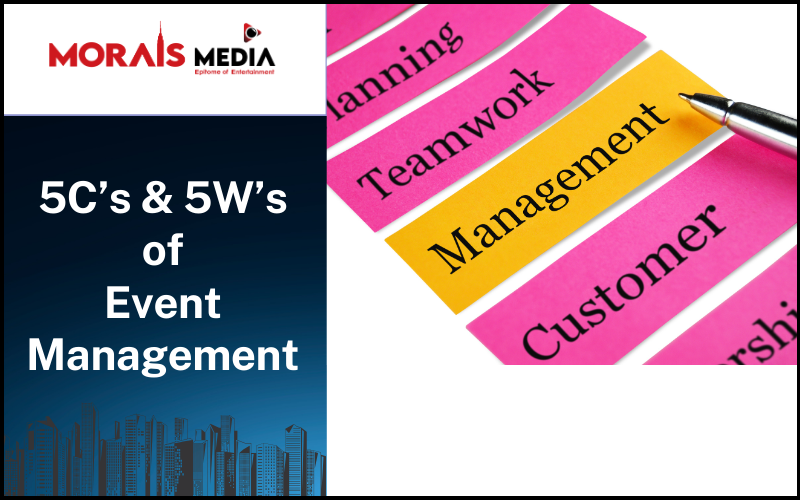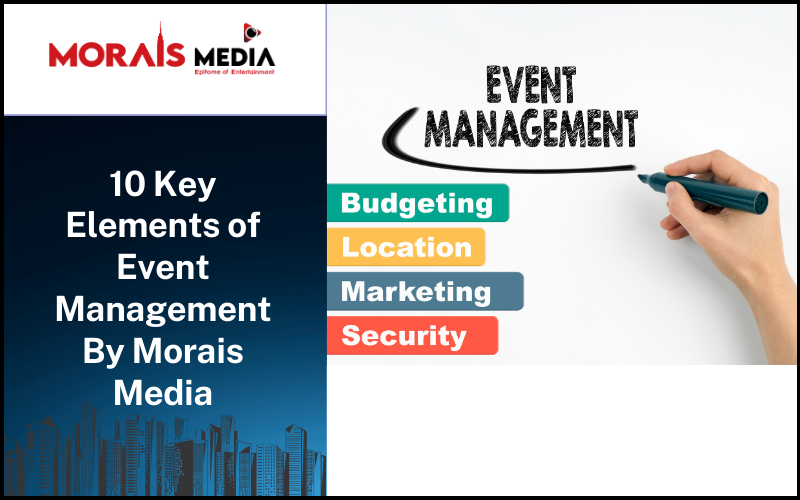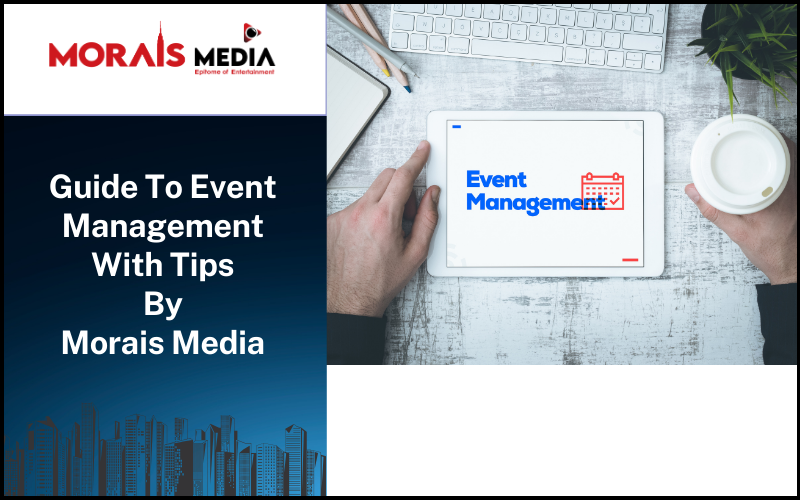
Event management is more than just organizing a gathering or a celebration—it’s about creating a meaningful and successful experience for everyone involved. A deep understanding of one’s target audience and meticulous attention to detail is essential when it comes to effective event planning.
Whether you’re managing an event, be it a corporate gathering or a team-building retreat, or a wedding, understanding the critical elements that make an event successful is key. That’s where the 5C’s and 5W’s of event management come into play. These are frameworks that guide event planners through the planning process from start to finish, ensuring a seamless and well-executed event. These serve as a blueprint for managing events effectively, ensuring that all bases are covered.
Let’s dive into the 5C’s and 5W’s of event management, with examples to illustrate their importance.
5C’s of Event Management
At the heart of event management lie the 5C’s: Concept, Coordination, Control, Culmination, and Closeout, which form the foundation of successful event planning. These essential components help event planners stay organized, prioritize tasks, and deliver a successful event.
1. Concept
The first step in event management is to define the concept of the event. This is the foundation on which the entire event is built. The concept involves the type of event, the purpose, and the key message you want to communicate to your target audience. For example, if you’re organizing a team-building event, the concept might revolve around improving communication, trust, and collaboration among employees. The clearer the concept, the easier it will be to make decisions about the venue, activities, and overall event arrangement.
Example: If you’re planning a wedding, the concept might be a “summer outdoor celebration” or a “formal ballroom affair.” The concept will serve as the guiding force behind all event decisions, from venue and décor to music and entertainment.

2. Coordination
Coordination involves aligning all the different elements required for the event—such as vendors, sponsors, volunteers, and staff—so that they work seamlessly together. Coordination requires a strong ability to manage multiple moving parts at once and ensure that everything is on schedule. This includes everything from booking the venue to managing logistics like catering and transportation.
Example: If you’re managing an event like a corporate seminar, coordination would include scheduling the speakers, organizing transportation for attendees, and ensuring that all technology, such as microphones and projectors, is in place for smooth presentations.

3. Control
Control means overseeing how the event is carried out. It’s about making sure that everything runs according to the prepared plan during the event itself. This includes overseeing the event setup, making sure that everything is functioning smoothly, and handling any issues that arise. Effective crowd management services are a part of this step, especially for larger events where ensuring the safety and comfort of attendees is crucial.
Example: During a large concert, control involves monitoring the crowd, ensuring security personnel are in place, and addressing any technical difficulties. Controlling these elements, one ensures the event proceeds without major disruptions.

4. Culmination
Culmination is when everything you’ve planned comes together. It’s the peak of the event where all activities are carried out as scheduled. At this stage, everything should be aligned with the concept, and the event should be unfolding as expected. This is where the event organizer ensures that the event is engaging and that attendees are having a positive experience.
Example: In a cultural festival, the culmination would be the performances, food stalls, and exhibitions, where attendees can engage and enjoy the full experience that was prepared for them.

5. Closeout
The final phase of event management is closeout. This stage includes finalizing event details, handling post-event responsibilities, and analyzing the event’s effectiveness. Closeout includes thanking participants, clearing up the venue, and reviewing what went well and what could be improved for future events. This stage also involves assessing whether the event met the goals set out in the concept phase, such as raising brand awareness.
Example: After a successful corporate gala, closeout might involve sending thank-you notes to attendees, collecting feedback from participants, and analyzing whether the event achieved its goal of boosting employee morale.

5 W’s of Event Management
The 5W’s are another crucial aspect of event management. These represent the essential questions that help to identify the fundamental components of the event.

1. Who
This question involves identifying the key participants of the event: the target audience, the event organizers, speakers, performers, and any special guests. Knowing “who” enables one to design the event that caters to the needs of the people involved.
Example: For a children’s day event, knowing “who” your target audience is will help in planning activities suited for children, such as games and entertainment tailored to their age group.
2. What
The ‘what’ aspect defines the event’s nature and scope, including the specific activities and programs scheduled. It focuses on the event’s objectives, such as educating the audience, celebrating an occasion, or launching a product. Determining “what” ensures the event is purposeful and aligns with the objectives.
Example: If the event is a charity fundraiser, “what” includes determining the fundraising goal, planning auctions, and entertainment, and arranging guest speakers who can attract donors.
3. When
The ‘when’ aspect focuses on scheduling the event, including choosing a specific date and creating a detailed timeline. Timing is critical to event success, especially when considering factors like weather, holiday schedules, and the availability of key people. It also includes scheduling the event’s flow, from registration to the final session or performance.
Example: For an outdoor wedding, selecting a season and time of day that ensures good weather is essential. For a corporate conference, choosing a date that doesn’t conflict with other industry events ensures better attendance.
4. Where
The “where” aspect involves the selection of venues and location to host the event. Whether it’s a conference room, outdoor park, or concert hall, choosing the right location ensures that the event is accessible, comfortable, and aligns with the event’s concept.
Example: A product launch may take place in a modern, high-tech venue that aligns with the brand’s image, whereas a team-building event might be best suited for an outdoor location with space for physical activities.
5. Why
Understanding “why” focuses on the purpose of the event. Why are you hosting this event? What are the goals? Whether the purpose is to build team morale, launch a product, or celebrate a special occasion, this helps shape every other aspect of the event.
Example: If the event is a holiday celebration for employees, the “why” could be to show appreciation and boost morale. This purpose will guide the choice of activities, location, and even the guest list.
Frequently Asked Questions
- What are the most important skills needed in event management?
It necessitates a combination of strong organizational abilities, clear communication, adept problem-solving, and effective leadership. These skills help in coordinating teams, managing resources, and ensuring that everything runs smoothly.
- How do I manage a large event?
Successful large event management involves careful planning, clear communication, and delegation of tasks. Using event planning software, hiring experienced staff, and organizing regular meetings for updates are key strategies for managing large events.
- What is post-event management?
It refers to activities that take place after the event concludes, such as feedback collection, follow-up communications, and debriefing to assess the event’s success.
- How do I manage a tight event budget?
To manage a tight event budget, prioritize essential services, negotiate with vendors, and seek sponsorships. Track every expense, and be flexible with your choices to ensure you’re staying within your budget while still delivering a high-quality experience.
- What should I include in an event timeline?
An event timeline should include key milestones, such as vendor confirmations, guest arrivals, speaker or performer schedules, and the time allocated for various activities (e.g., registrations, sessions, breaks, etc.). This helps keep everyone on track.
Conclusion
Event management is a complex yet rewarding process that requires attention to detail, creativity, and strategic planning. The 5C’s and 5W’s provide a structured approach to managing events that ensures all aspects—from concept to closeout—are considered and handled effectively. Whether you’re organizing a corporate event, or community festival, understanding these frameworks will help you create successful and memorable experiences for your target audience. Through careful event planning and diligent execution, you can achieve your goals and leave a lasting impression on attendees.

